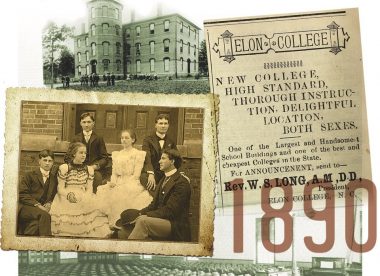See what campus life was like for the 76 students who enrolled in Elon’s first academic year.
 As the incoming Class of 2019 prepares to mark its first days as an official part of the university community, Elon historian George Troxler shared with The Magazine of Elon some interesting facts about Elon’s first students who enrolled on Sept. 2, 1890.
As the incoming Class of 2019 prepares to mark its first days as an official part of the university community, Elon historian George Troxler shared with The Magazine of Elon some interesting facts about Elon’s first students who enrolled on Sept. 2, 1890.
Elon’s first opening convocation began at noon and, as it is today, was held Under the Oaks. The program included eight speakers along with hymns, scripture and prayer. The speakers focused their remarks on the importance of the school for the community, along with its plans and needs. But rather than neatly arranged seating and carefully designed pathways, students and their families sat on boards stacked on top of wooden blocks, which had been quickly constructed to accommodate the audience. Following the program, students and their families enjoyed a picnic and at 4 p.m., Elon’s first 76 students officially enrolled for classes, which began the next day.
So who were these students? Unlike this year’s incoming class, which hails from across the country and around the world, these students were from North Carolina or Virginia. They included both men and women, which was unusual for the time. And only 30 took college-level courses—the rest were in the academic or preparatory program. The youngest was just 13 years old.
Rather than today’s seven residential neighborhoods, campus housing was an ad hoc affair. Many of the female students roomed with local residents while dormitories were under construction. Even President William S. Long’s daughter, Anne Long Holleman, pitched in to help. She and her husband, Professor Silas A. Holleman, housed women, four to a room, and hosted them for meals. East Dormitory was completed that December, and the women moved into their rooms before leaving for holiday break. Some of the male students rented rooms in private houses and chipped in to buy food, hire a cook and rent a house where their meals were prepared and served.
Most of the men lived in the third floor of the Administration Building, which was still under construction. The windows on that floor had not yet been placed and many of the building’s doors had not been hung. Writing an account of his time at Elon, Herbert Scholz, a member of the Class of 1891, recalled in a Maroon and Gold article that first night he had “a mattress to sleep on but no pillow nor cover. … Bugs and gnats were as plentiful as in the forest primeval.” The men who were to live in the Administration Building arrived on campus for Move-in Day on Sept. 1. Rather than spending that day hauling boxes with their parents or rearranging décor, the men were greeted by faculty making wash stands, tables and benches to furnish the students’ rooms.
And while the rooms had fireplaces to provide heat during the winter, students were responsible for gathering and providing their own wood for fires. Luckily, logs and branches were readily available around campus because many had not been cleared when trees were cut down to construct the college. Men enrolled in college classes paid $145, which included tuition, room and board. Women paid $170 but that included a furnished room, fuel, light and regular cleaning, which was not offered to the men.
The students’ social lives during those early years revolved around religious organizations, literary societies and music groups. Students enrolled in college classes chose between a classical course leading to a bachelor of arts degree or a philosophical course leading to a bachelor of philosophy degree, with both programs requiring students to take Latin, algebra, geometry, zoology and botany, constitutional and international law, logic and ethics classes.
While much has changed in the past 125 years, the power of the relationships forged on campus was as strong then as they are now. In the words of Professor James O. Atkinson, who, thinking back to the school’s first year, wrote in The Christian Sun: “School days have their ‘ups and downs,’ some trials and crosses, but they are the happiest after all. There are no ties more tender, no friends dearer to us than those formed during our school days, ‘chums,’ room-mates and class-mates live in our memory.”


